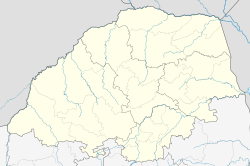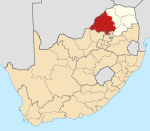Modimolle
Modimolle
Nylstroom | |
|---|---|
| Coordinates: 24°42′00″S 28°24′22″E / 24.70000°S 28.40611°E | |
| Country | South Africa |
| Province | Limpopo |
| District | Waterberg |
| Municipality | Modimolle–Mookgophong |
| Area | |
• Total | 74.9 km2 (28.9 sq mi) |
| Population (2011)[1] | |
• Total | 8,671 |
| • Density | 120/km2 (300/sq mi) |
| Racial makeup (2011) | |
| • Black African | 44.3% |
| • Coloured | 1.1% |
| • Indian/Asian | 0.7% |
| • White | 53.6% |
| • Other | 0.3% |
| First languages (2011) | |
| • Northern Sotho | 27.4% |
| • Afrikaans | 53.2% |
| • English | 4.1% |
| • Tsonga | 3.8% |
| • Other | 11.5% |
| Time zone | UTC+2 (SAST) |
| Postal code (street) | 0510 |
| PO box | 0510 |
| Area code | 014 |
Modimolle, also known as Nylstroom, is a town located near the southern edge of the Waterberg Massif in Limpopo province, South Africa. It is a medium-sized town that focuses primarily on agriculture and farming (citrus, grapes and cattle) as well as wildlife and tourism. Nylstroom is also located approximately 135 kilometres (84 miles) north of Pretoria, South Africa's capital city.
The Waterberg Biosphere spreading north, a UNESCO designated Biosphere Reserve, contains approximately 15,000 square kilometres (5,792 square miles). Waterberg is the first region in the northern part of South Africa to be named as a Biosphere Reserve by UNESCO. The extensive rock formation was shaped by hundreds of millions of years of riverine erosion to yield diverse bluff and butte landform.[2] The ecosystem can be characterised as a dry deciduous forest or Bushveld.
History
[edit]In the 1860s, a group of Voortrekkers known as the Jerusalem Trekkers set off for the Holy Land. After discovering a wide river flowing northwards, they consulted the maps at the back of their Bibles and decided that it was the Nylrivier (Nile river).[3] They called the stream Nyl River and settled the town and called it Nylstroom in 1866.[4][5] After discovering what they believed to be a ruined pyramid, they were convinced that they had found the Nile. It was in fact, a natural hillock, known to the locals as Modimolle.[6] In March 1866, the district of Waterberg was created out of some of the districts of Rustenburg and Zoutpansberg with a landdrost established in Nylstroom.[7]: 230 A Dutch Reformed Church was built in 1889 and is the oldest church in South Africa north of Pretoria. It was also used as a hospital during the Second Boer War. The river is the Nyl River, a tributary of the Mogalakwena River.
The first South African railway line reached Modimolle in 1898, connecting the town to Pretoria. During the Second Boer War, the British government operated a concentration camp in Modimolle, where Boer women and children where interned as part of the Lord Kitchener's scorched earth policy. 544 of those interned at the camp died of various causes before it was closed upon the conclusion of the war in 1902. Strijdom Huis (Strijdom House) was the primary residence of the 6th Prime Minister of South Africa, JG Strijdom, and is situated in Modimolle.[8]
Name change
[edit]The South African government officially changed the name of the town to Modimolle in 2002.[9] The name comes from the Sotho-Tswana phrase, Modimo o lle, meaning "the forefather's spirit has eaten", or "God has eaten".[5][10]
Other numerous name changes include the renaming of both a municipal building and the town hall after Oliver Tambo, the library being renamed the Ruth First Memorial Library, as well as the renaming of several streets.[11]
Notable people
[edit]- Christiaan Beyers - Boer general, and Commandant-General of the Union Defence Force[3]
- Carel Boshoff - Professor of theology and Afrikaner white nationalist[12][13]
- Lucas Malan - Afrikaans academic and poet
- Eugène Marais - Poet, journalist, lawyer, naturalist and author[3]
- Gerard Moerdijk - Architect[3]
- Johannes Gerhardus Strijdom - 5th Prime Minister of South Africa[14]
- Nelson Makamo - South African visual artist.
References
[edit]- ^ a b c d [1] from Census 2011.
- ^ C.Michael Hogan, Mark L. Cooke and Helen Murray, The Waterberg Biosphere, Lumina Technologies, May 22, 2006. "Lumaw". Archived from the original on 2012-03-01. Retrieved 2010-06-10.
- ^ a b c d Maxwell Leigh (1986). Touring in Southern Africa (First ed.). C. Struik Publishers. p. 156.
- ^ William Taylor, Gerald Hinde and David Holt-Biddle, The Waterberg, Struik Publishers, Cape Town, South Africa (2003) ISBN 1-86872-822-6
- ^ a b "Modimolle". Encyclopedia.com. Retrieved 2010-03-26.
- ^ Denis Worral (1980). Vic Mayhew (ed.). Illustrated Guide to Southern Africa (Second revised (1980) ed.). The Reader's Digest Association South Africa (Pty.) Ltd. p. 244.
- ^ Theal, George McCall (1889). History of South Africa: the republics and native territories from 1854 to 1872. London: S. Sonnenschein & co.
- ^ "Strijdom bust carted off to 'place of safety'". Independent Online. 2002-02-26. Retrieved 2010-03-25.
- ^ "Official South African Geographical Names System: Old Place Names starting with N". South African Department of Arts and Culture. 2002-06-14. Retrieved 2010-03-25.[permanent dead link]
- ^ "Meanings of place names in South Africa". African Languages. Retrieved 2010-03-26.
- ^ "New names have town in a tizz". News24. 2005-01-20. Retrieved 2009-09-28.[permanent dead link]
- ^ "Carel Boshoff". Telegraph. 2011-03-17. Retrieved 26 August 2014.
- ^ Weber, Bruce (19 March 2011). "Carel Boshoff, Founder of White Redoubt in South Africa, Dies at 83". The New York Times. Retrieved 31 March 2022.
- ^ "Johannes Gerhardus Strijdom". Britannica Online Encyclopedia. Retrieved 2010-03-25.




